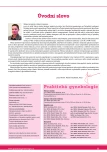-
Medical journals
- Career
Seminal plasma proteome in men with azoospermia
Authors: I. Crha 1; H. Konečná 2; J. Žáková 1; J. Buršíková 2; Z. Zdráhal 2; E. Lousová 1; P. Ventruba 1; M. Pohanka 1
Authors‘ workplace: Gynekologicko-porodnická klinika, LF MU a FN Brno 1; Oddělení funkční genomiky a proteomiky, Přírodovědecká fakulta a CEITEC, Masarykova univerzita, Brno 2
Published in: Prakt Gyn 2011; 15(2): 60-63
Category: Original Article
Overview
Objective:
Seminal plasma is a potential source of biomarkers of many disorders of male reproductive organs. Identification and characterization of individual proteins in seminal plasma could be a useful tool for estimating male infertility. The aim of the study was to analyze proteome differences in men with azoospermia and normospermia.Material and methods:
Samples of seminal plasma from men with azoospermia and normospermia were collected and cryopreserved in liquid nitrogen. Detergent CHAPS was used to solubilize the sample proteins. Two dimensional (2-D) gel electrophoresis was used to separate protein isolates. Immobilized gradient pH 3–10 NL was used for isoelectric focusation and 12% SDS-PAGE was used for second dimension. Sypro Ruby dye was used to stain the proteins. Software PDQuest was used to analyze quantitative and qualitative differences. Selected proteins were digested by trypsin and identified by MALDI-MS/MS or LC-MS/MS and (using) the Mascot software.Results:
Six azoospermia and six normospermia samples were analyzed. Minimal differences in proteomic profile were found among normospermia samples. Significant quantitative and qualitative differences were detected between men with normospermia and azoospermia. Image analysis and mass spectrometry identified eighteen different proteins.Conclusion:
Eighteen proteins were found that could serve as potential markers of azoospermia. These results provide an important basis for comparative proteomics of infertility and oxidative stress.Key words:
proteome – male infertility – azoospermia – oxidative stress
Sources
1. Nixon B, Aitken RJ. Proteomics of human spermatozoa. In: Krause WK, Naz RK (eds). Immune infertility: The impact of immune reactions on human infertility. Heidelberg: Springer-Verlag 2009.
2. WHO laboratory manual for the Examination and processing of human semen. 5th ed. Ženeva: World Health Organization 2010.
3. Martínez-Heredia J, de Mateo S, Vidal-Taboada JM et al. Identification of proteomic differences in asthenozoospermic sperm samples. Hum Reprod 2008; 23(4): 783–791.
4. Yamakawa K, Yoshida K, Nishikawa H et al. Comparative analysis of interindividual variations in the seminal plasma proteome of fertile men with identification of potential markers for azoospermia in infertile patients. J Androl 2007; 28(6): 858–865.
5. Oborná I, Fingerová F, Hajdúch M et al. Lykopen v terapii mužské plodosti. Čes Gynek 2007; 72(5): 326–329.
6. Oborna I, Wojewodka G, De Sanctis JB et al. Increased lipid peroxidation and abnormal fatty acid profiles in seminal and blood plasma of normozoospermic males from infertile couples. Hum Reprod 2010; 25(2): 308–316.
7. Crha I, Kralikova M, Melounova J et al. Seminal plasma homocysteine, folate and cobalamin in men with obstructive and non-obstructive azoospermia. J Assist Reprod Genet 2010; 27(9–10): 533–538.
8. Oliva R, Martínez-Heredia J, Estanyol JM. Proteomics in the study of the sperm cell composition, differentiation and function. Syst Biol Reprod Med 2008; 54(1): 23–36.
Labels
Paediatric gynaecology Gynaecology and obstetrics Reproduction medicine
Article was published inPractical Gynecology

2011 Issue 2-
All articles in this issue
- Postcoital contraception up to date
- Differential diagnosis of vulvovaginitis
- Aortic dissection in a pregnant patient with Turner syndrome
- Probiotics in gynaecology
- GyneFix – a frameless intrauterine device
- Seminal plasma proteome in men with azoospermia
- The prognostic value of the SCCA tumour marker in patients surgically treated for squamous cell cervical cancer
- Pharmacotherapy of endometriosis in reproductive gynaecology
- The role of homocysteine and related thiols in etiopathogenesis of human reproduction disorders
- Non-tumour pain in gynaecology and options for its treatment
- Practical Gynecology
- Journal archive
- Current issue
- Online only
- About the journal
Most read in this issue- GyneFix – a frameless intrauterine device
- Pharmacotherapy of endometriosis in reproductive gynaecology
- The prognostic value of the SCCA tumour marker in patients surgically treated for squamous cell cervical cancer
- Probiotics in gynaecology
Login#ADS_BOTTOM_SCRIPTS#Forgotten passwordEnter the email address that you registered with. We will send you instructions on how to set a new password.
- Career

